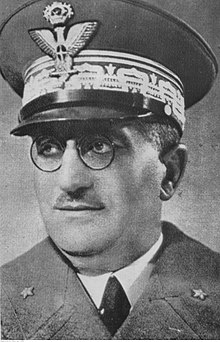Ugo Cavallero
Ugo Cavallero (born September 20, 1880 in Casale Monferrato , † September 14, 1943 in Frascati ) was an Italian field marshal . From December 1940 to January 1943 he was Pietro Badoglio's successor to the post of Chief of Staff of the Italian Armed Forces ( Comando Supremo ).
Life
Cavallero came from a respected Piedmontese family. From 1898 to 1900 he attended the Military Academy in Modena and then served in the 59th Infantry Regiment. In 1911 he completed his general staff training as the best in the course. In his free time he worked as a translator of works on geographic and historical topics in English and German.
During the First World War Cavallero served briefly with the 1st Alpini Regiment, then with the General Staff of the Army, where he quickly made a career and distinguished himself as chief of the operations department in planning the Piave battles . As Brigadier General, he headed the Italian delegation to the Standing Committee of the Entente in Versailles in 1919/20 .
In 1920 Cavallero took a leave of absence and worked for the Pirelli company . When Mussolini himself took over the management of the ministries for war, navy and aviation , Cavallero was reactivated in May 1925 and, as state secretary, de facto headed the war ministry . In 1927 Cavallero fell out with the Chief of Staff of the General Armed Forces Pietro Badoglio over issues of the distribution of powers between the General Staff of the Army and that of the armed forces. For the next ten years Cavallero worked as chairman of the board at Ansaldo and at a disarmament conference in Geneva . From 1938 to 1940, he served as lieutenant general in Italian East Africa , where he was promoted to general in May 1940 .
When Marshal Pietro Badoglio resigned from the post of Chief of Staff of the Armed Forces in December 1940, Cavallero took over this task and immediately tried to get the extremely negative development of the military situation in Italy in the Greco-Italian War under control. He went himself to Albania and there managed to stop the Greek advance. After this unfortunate campaign, in the spring of 1941 he called for a reorganization of the military command structures. With a law of June 27, 1941, the General Staff of the Armed Forces ( stato maggiore generale ) was permanently upgraded and renamed Comando Supremo , which, under Cavallero, gradually managed to achieve more uniform management of military operations.
Ugo Cavallero was appointed " Marshal of Italy " on July 1, 1942 , mainly because Rommel , who was officially under him , had been promoted to field marshal general. Some circles in Rome despised Cavallero because of his closeness and his relatively good relationship with the Germans. For this reason he was sometimes referred to as a “boot licker”.
In January 1943, General Vittorio Ambrosio replaced him as head of the Comando Supremo . After Mussolini was deposed, Cavallero was imprisoned by the new Badoglio government . On September 12, 1943, German troops liberated him from the Forte Boccea prison and brought him to Albert Kesselring's high command in Frascati . Adolf Hitler offered him command of all Italian troops that wanted to continue participating in the war on the German side, but Cavallero refused. On September 14, 1943, the day he was scheduled to leave for Munich , Cavallero shot himself in the garden of the Belvedere hotel in Frascati.
literature
- Lucio Ceva: Il maresciallo Cavallero. In: Storia Militare. No. 19, April 1995, ISSN 1122-5289 , pp. 4-12.
- Lucio Ceva: Cavallero, Ugo. In: Alberto M. Ghisalberti (Ed.): Dizionario Biografico degli Italiani (DBI). Volume 22: Castelvetro – Cavallotti. Istituto della Enciclopedia Italiana, Rome 1979.
- Lucio Ceva: La condotta italiana della guerra. Cavallero e il Comando supremo 1941/1942 (= I fatti e le idee 294 Storia , ZDB -ID 981419-x ). Feltrinelli, Milan 1975.
- Stato Maggiore dell'Esercito: Gli Ufficiali di SM Caduti in Guerra. Tipografia regional, Rome 1954.
Web links
- Biography on difesa.it
- Newspaper article about Ugo Cavallero in the 20th century press kit of the ZBW - Leibniz Information Center for Economics .
| personal data | |
|---|---|
| SURNAME | Cavallero, Ugo |
| BRIEF DESCRIPTION | Italian field marshal |
| DATE OF BIRTH | September 20, 1880 |
| PLACE OF BIRTH | Casale Monferrato |
| DATE OF DEATH | September 14, 1943 |
| Place of death | Frascati |
